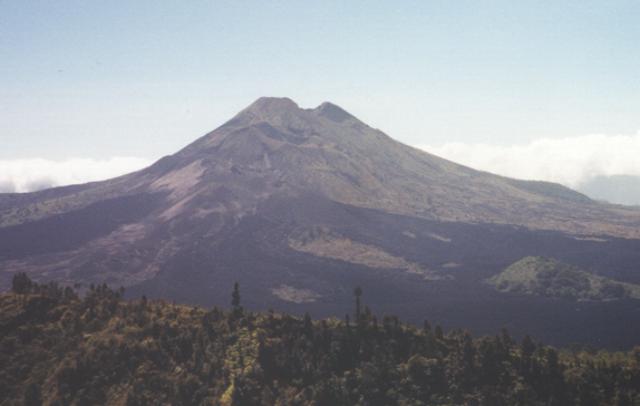Report on Batur (Indonesia) — October 2000
Bulletin of the Global Volcanism Network, vol. 25, no. 10 (October 2000)
Managing Editor: Richard Wunderman.
Batur (Indonesia) Frequent ash emissions and explosions since August 1999
Please cite this report as:
Global Volcanism Program, 2000. Report on Batur (Indonesia) (Wunderman, R., ed.). Bulletin of the Global Volcanism Network, 25:10. Smithsonian Institution. https://doi.org/10.5479/si.GVP.BGVN200010-264010
Batur
Indonesia
8.2403°S, 115.3775°E; summit elev. 1711 m
All times are local (unless otherwise noted)
Intermittent explosive activity has continued since July 1999 (BGVN 24:06). The following report covers the periods of August-September 1999, February-June 2000, and August-September 2000. Reports were not available for the interim periods. However, there was no activity on 20 July 2000 (figure 2) when participants attending the IAVCEI General Assembly visited the caldera (see Sutawidjaja, 2000).
 |
Figure 2. Photograph of the active cone at Batur, 20 July 2000. View is looking NE from Penelokan on the caldera rim. Courtesy of Edward Venzke, SI. |
In August 1999, Batur Post Observatory (BPO) observed frequent ash emissions and small explosions. Ash eruptions varied in height from 5 to 150 m above the volcano's crater rim. Some explosive events were accompanied by ejection of lava; the material rose 10-25 m, and incandescence could be observed at night. Explosion earthquakes dominated seismicity, which increased relative to the previous month. Frequent rumbling of varying intensity could be heard in the vicinity of Batur. During September, ash ejection increased in height, ranging from 25 to 250 m. Incandescent material continued to erupt from the crater. Seismicity continued to increase; seismographs recorded explosion earthquakes with amplitudes of 2-28 mm.
Ash emission, lava ejection, and mild explosions occurred during February 2000. Ash rose 25-250 m above the summit. Ejection of molten material accompanied some explosions. Rumbling could be heard frequently around the volcano. Overall seismicity was lower than in September 1999; fewer explosion earthquakes and slightly more shallow volcanic (B-type) earthquakes occurred. In the middle of the month, a gray ash plume rose up to 300 m above the summit. Ejected material fell up to 50 m from the center of the crater. By the end of February, ash emissions rose 10-50 m above the summit. Explosion frequency and intensity decreased. Low-density, white ash-and-gas emissions rose up to 75 m in early March. In mid-March the ash plume rose 10-25 m. Audible rumbling ceased, and seismicity decreased substantially.
On 22-23 March, a large explosion issued from the crater; ejecta were sent 200 m above the rim and rained back down within the crater. Seismicity increased along with the frequency of explosion earthquakes. Explosions and ash emissions continued into April, when ash and explosion debris reached up to 300 m in height, and rumbling resumed. Seismicity decreased by the end of the month. By early May, emission had decreased to a low-density, white ash-and-gas plume and rose 5-25 m above the crater rim. Rumbling ceased. Similar emissions and seismicity remained through the end of June. During August-September, a low-density, white plume rose up to 10 m above the crater rim, and seismicity maintained relatively low levels.
Reference. Sutawidjaja, Igan S., 2000, A guide to the geological phenomena of Batur Caldera, Bali, Indonesia: Fieldtrip guide prepared for the IAVCEI General Assembly, Bali, Indonesia, 33 p.
Geological Summary. The historically active Batur is located at the center of two concentric calderas NW of Agung volcano. The outer 10 x 13.5 km caldera was formed during eruption of the Bali (or Ubud) Ignimbrite about 29,300 years ago and now contains a caldera lake on its SE side, opposite the Gunung Abang cone, the topographic high of the complex. The inner 6.4 x 9.4 km caldera was formed about 20,150 years ago during eruption of the Gunungkawi Ignimbrite. The SE wall of the inner caldera lies beneath Lake Batur; Batur cone has been constructed within the inner caldera to a height above the outer caldera rim. The Batur stratovolcano has produced vents over much of the inner caldera, but a NE-SW fissure system has localized the Batur I, II, and III craters along the summit ridge. Recorded eruptions have been characterized by mild-to-moderate explosive activity sometimes accompanied by lava emission. Basaltic lava flows from both summit and flank vents have reached the caldera floor and the shores of Lake Batur in historical time.
Information Contacts: Dali Ahmad, Volcanological Survey of Indonesia (VSI), Jalan Diponegoro No. 57, Bandung 40122, Indonesia (URL: http://www.vsi.esdm.go.id/).

